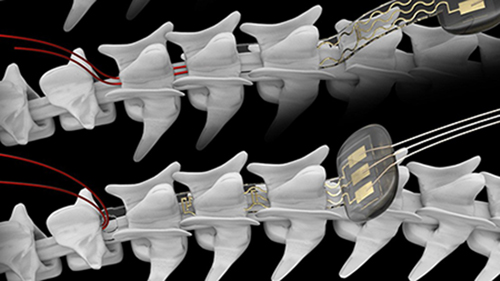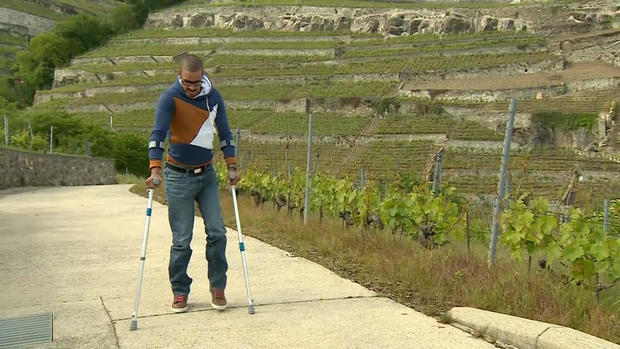At BML Technology we are privileged to work backstage with some of the most exciting digital health organizations in the world doing groundbreaking and innovative work. Our front row perspective into the digital health solutions of the future is one of the reasons we are so passionate about the work that we do. Every now and then however, a new medical technology comes along that makes us realize we’ve reached an era where it seems that truly anything is possible.
Spine implant stimulates spinal cord neurons to allow three paralyzed individuals to stand, walk, swim and even pedal a bicycle
A spinal cord implant system developed by Grégoire Courtine and Jocelyne Bloch at the Swiss Federal Institute of Technology in Lausanne (EPFL) has enabled patients with a complete spinal cord injury to stand, walk and even perform recreational activities like swimming, cycling and canoeing. The technology is described in a paper published on February 7th in the journal Nature.
Grégoire Courtine holds a PhD in Experimental Medicine, is a Full Professor at the EPFL and a leading authority in spinal cord repair and radical new approaches to restoring function after spinal cord injury. Jocelyne Bloch is a Swiss neuroscientist and a neurosurgeon at Lausanne University Hospital (CHUV) and at EPFL. She is a leading expert in deep brain stimulation and brain repair in relation to movement disorders.
Together with Grégoire Courtine she leads the Neurorestore Laboratory, jointly managed by the University of Lausanne, the Lausanne University Hospital (CHUV), the Defitech Foundation and the EPFL. NeuroRestore is a research, innovation and treatment center that develops and applies bioengineering strategies involving neurosurgical interventions to restore neurological functions.
See how the spine implant solution developed at Neurorestore is enabling paraplegics to walk again
How does the NeuroRestore Laboratory spinal implant work
In spinal cord injuries there is a breakdown or disruption in the functioning and quality of the electrical signal communication between the brain and the extremities when these signals become either too weak to create movement or non existent. Typically a severed spine results in a loss of mobility that is complete, permanent and was until now irreversible.
The NeuroRestore spinal implant electrically stimulates the nerves of the back and spine that are not receiving the appropriate electrical signals from the brain to mimic those impulses and thereby enable movement. This is also possible because in many cases the motor neurons that are found below the spinal break are intact and thus only in need of the appropriate stimulation to be reactivated.
The NeuroRestore team repurposed existing spinal implant technology normally used in the treatment of chronic pain modifying these stimulators to target specific nerves and locations involved in controlling the muscles of the legs and lower trunk.

The implants and the impulses they generate were customized for each individual to the point of the exact location of each implanted electrode on the spine – there are sixteen electrodes – and the patient is able to activate them remotely from a watch or tablet device when they want to perform specific tasks. The implant provides custom stimulation patterns based on the activity the individual wishes to perform such as walking, swimming or cycling.
“All three patients immediately after the surgery were able to stand up and to step [with support],” says Jocelyne Bloch at Lausanne University Hospital in Switzerland, who carried out the surgery. This is also a major improvement to existing efforts in the field as prior implants necessitated months of rehabilitation and training prior to the patient being able to attempt movement.

There is still a long way to go before the technology can be used on a mass scale to help paralysed people walk again. The technology is invasive, requires a lot of customization, as well as the neurostimulator implant in the abdomen and ongoing monitoring and rehabilitation. However it is clear that this innovation represents an immense step forward in the field and as some of the technical challenges are addressed we can expect a brighter future of freedom of movement for individuals afflicted with these conditions.
The team has received approval from the US Food and Drug Administration to test the system in a US-based clinical trial with more people. We look forward to the results, hope for a positive outcome and will follow the story with interest.
About BML Technology
BML Technology understands digital health. At the intersection of medical technology, clinical research and patient-centric healthcare BML drives the mainstream adoption of digital technology in healthcare. Offering a full range of services to the digital health ecosystem BML manages the complex stakeholder interactions necessary to get digital health solutions to market and gain adoption.
Stay Connected with BML Technology.
Connect with BML Technology on LinkedIn.


